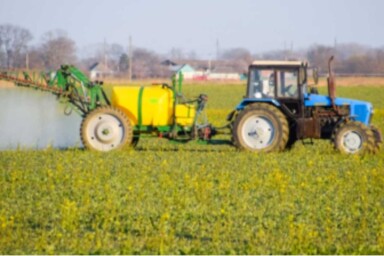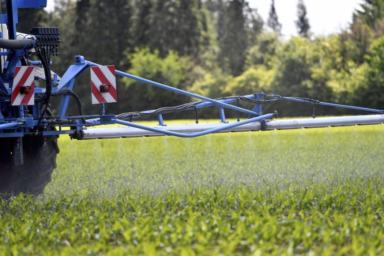In India, air pollution is cutting yields of wheat and rice crops in half, according to a study from 2014. Researchers mostly attribute this to ground level ozone (O3), a short-lived pollutant that exists in the atmosphere for weeks or months. O3 gas is formed when nitrogen oxides, which are produced in combustion processes and mostly released from power stations and vehicles, react with air pollutants, including vehicle exhaust, oil refining, petrochemicals and bushfires during sunlight.
Researchers found that between 1980 and 2010 yields were up to 36% lower than what they would have been without air pollution trends. In 2010, this loss was the equivalent of more than 24 million tonnes of wheat in India, worth around $5 billion.
“A main precursor of O3 is vehicle pollution in cities, and levels of O3 are much greater in hot sunny conditions,” says Fiona Marshall, professor of environment and development at the University of Sussex. As the earth’s temperature increases with global warming, this will further increase levels of O3. Marshall further adds that polluting industries are often moved out of cities into areas surrounded by agriculture, where emissions are closer to crops and therefore have a more immediate impact on yields.
In India, these high levels of pollutants – which, in major cities, often surpass the safe limit – don’t look set to change any time soon.
“An increasing proportion of agricultural land is being affected by air pollution in India as cities expand and agriculture land use is interspersed with built-up areas and industry,” says Marshall.
Ozone has a damaging impact on plants. When O3 is absorbed via the pores on the leaf surface, it forms free radicals that attack cell membranes. This causes yellowing, cell injury, irregular spots, bronzing and reddening that affects the flowering and growth of crops, reducing their yield. It is thought to be the most important air pollutant affecting crop growth and productivity, says Lisa Emberson, centre director of Stockholm Environment Institute at the University of York.
“Current estimates suggest that O3 is causing between 5% and 12% yield losses globally in staple crops, which include wheat, rice, maize, soybean,” she says. Associated economic losses from affected crops are estimated to be up to $20 billion per year.
Research by the UK’s Centre for Ecology & Hydrology estimates that 03 reduces the yield of wheat, rice, maize and soybean by up to 227 million tonnes a year globally, including in North and South America, India, China, the US, Bangladesh and Indonesia. The highest production losses caused by 03 for soybean are in North and South America, for wheat, they are in India and China, for rice, in parts of India, Bangladesh, China and Indonesia, and for maize, in China and the US. The most affected areas are also often at risk of high losses from pests and diseases and heat stress.
The critical levels set by the United Nations as a target for O3 pollution control in 2016, are exceeded in many areas of the world, says Katrina Sharps, spatial data analyst at the Centre for Ecology & Hydrology at the Environment Centre Wales.
“The highest ozone levels are in many of the world’s important crop growing regions. Ozone concentrations are increasing in rapidly developing regions – for example, East Asia and Southeast Asia – and are predicted to continue to increase over the coming decades,” she says.
Sharps has found through research that O3 impacts were predicted in areas of the world where the largest yield gaps occur, including parts of South America, Sub-Saharan Africa and East Asia, where factors such as nutrient limitation and irrigation availability are known to be affecting yield. This could be detrimental to food security since it would directly impact farmers in Africa who rely on subsistence farming, growing enough food to feed themselves and their families.
“Crop losses due to ozone may reduce the likelihood of meeting the United Nations Sustainable Development Goal to end hunger, achieve food security, improve nutrition, and promote sustainable agriculture by 2030,” Sharps says.
“It is anticipated that considerably greater production of grain crops such as wheat, soybean, maize and rice will be required. Our research shows that the total ozone effects on wheat yield were twice as high in developing countries [than] in developed countries, where more yield is urgently needed to feed the growing population.”
Emberson says the future damage to food security caused by O3 depends on how emission reduction is implemented in future decades. Research has found that European ozone levels have increased rapidly since the 19th century, although peak concentrations recorded in 2003 and 2006 were around half that of levels recorded in 1976.
“Cause for concern is that in many parts of Asia, where O3 impacts are high in important agricultural regions such as the Indo-Gangetic plain and Eastern China, emissions look to continue for the next few decades, which may exacerbate already high O3 levels and associated yield losses,” she says.
Overcoming this won’t be easy, says Sharps, and it requires global action.
“Ozone pollution is a global problem requiring investments from industry and governments from around the world,” she says. “Further international agreements on reducing ozone pollution are urgently needed, however, this is a long-term goal which will take time to be implemented.”
Researchers are also looking at short-term solutions, including breeding new varieties of crop that are more resilient to ozone; better timing of irrigation, which has been found to promote ozone uptake; and the development of non-toxic agrichemicals, as toxic agrichemicals generate pollution. They say most crop breeding programmes have been targeted at increasing or maintaining the yield rather than increasing stability of yield under stress.
Researchers and farmers can also work together to avoid high levels of O3, Sharps says.
“Under certain conditions such as warm, sunny, weather, ozone episodes can occur, with ozone concentrations in the air peaking for several days at a time. It may be possible for researchers to forecast when an ozone episode may be about to occur and advise farmers to reduce irrigation during this time.”
Another short-term option, Marshall says, is to routinely screen crop varieties that are going to be grown in polluted areas for air pollution resistance, alongside other tests for tolerance to drought or salinity, enabling resistant varieties to be developed.
“Local farmers who are able to select their own seed may be already selecting those that are resistant to air pollution, but this won’t be the case for the increasing proportion of farmers that are dependent on large-scale seed suppliers,” she says.
In India, some farmers are finding they are unable to save their seeds and plant the varietals they want, due to their contracts with agribusiness.
Marshall says there needs to be more field research to help quantify the impacts of air pollution on crop yield and quality – but says it won’t be easy. “We need to know more about how it affects different types of crops and farming practices, and the implications for different groups of people, in terms of food security.
“A first step is to have a more formal recognition of the threat that air pollution poses to crop yield, and potentially to nutritional value and quality. As a largely invisible threat, this is challenging.”




